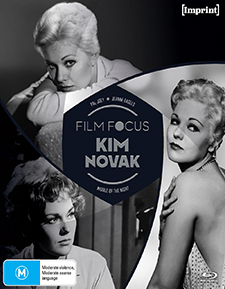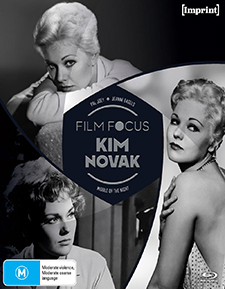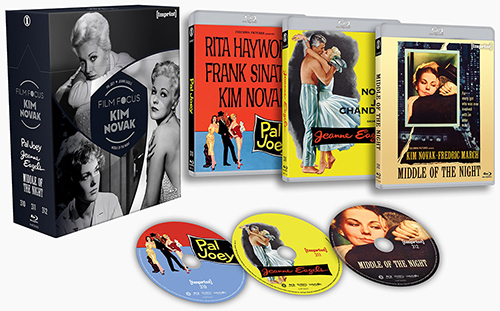Film Focus: Kim Novak (Blu-ray Review)

Director
George Sidney, Delbert MannRelease Date(s)
1957-1959 (April 24, 2024)Studio(s)
Columbia Pictures (Imprint Films/Via Vision Entertainment)- Film/Program Grade: See Below
- Video Grade: A-
- Audio Grade: A
- Extras Grade: B-
Review
[Editor's Note: This is a Region Free Australian Blu-ray import.]
When Columbia Pictures groomed Kim Novak (b. 1933) for stardom, they envisioned a kind of cross between Rita Hayworth, the studio’s top star of the ‘40s and early ‘50s, and Marilyn Monroe. In truth Novak ended up nothing like those personalities, but became a top star nonetheless. She starred or co-starred in just two dozen or so films, many forgotten, a few justly so. But she starred in Picnic and The Man with the Golden Arm and, of course, Alfred Hitchcock’s Vertigo. She was also in the noir gem 5 Against the House and, later in her career made appearances in movies of widely varying quality, including the strangely beguiling The White Buffalo. For me, her finest performance was as Polly the Pistol, the sweet-natured prostitute who finds that she enjoys masquerading as an ordinary housewife with a fiercely protective husband in Billy Wilder’s hilarious, sweet, and much-underrated Kiss Me, Stupid.
Imprint’s Film Focus: Kim Novak, a boxed set of three Novak-Columbia titles—Pal Joey, Jeanne Eagels (both 1957), and Middle of the Night (1959)—demonstrates just how difficult it must have been to find leading roles for the uniquely talented actress. Packaged in a sturdy box, each film gets its own separate case and disc, though the extras all appear repurposed from an earlier DVD release in the U.S. by Sony.
PAL JOEY
Pal Joey (1957) is a musical of big plusses and big minuses. Originally a 1940 Rodgers & Hart Broadway musical with a book by John O’Hara, he adapting his series of short stories, the show helped launch the careers of star Gene Kelly and his dancer-collaborator Stanley Donen. It was an innovative work in that its hero, nightclub performer (primarily a dancer) Joey Evans, was a charming but manipulative, womanizing heel, an unlikable anti-hero. The show received mixed reviews for that reason but was a big success, though its 1952 Broadway revival was much better received and for decades held the record as the longest-running revival of a Broadway musical.
The movie, co-produced by star (though second-billed) Frank Sinatra and director George Sidney, heavily reworked the material to make Frank’s part less unsavory, and the overall production more a vehicle for Sinatra’s crooning. For fans of his Capitol Records period, Pal Joey serves as an ideal instrument to showcase Sinatra’s talent. The cinematography by Harold Lipstein is also outstanding, making particularly good use of 1950s San Francisco locations, top-billed Rita Hayworth and third-billed Kim Novak have a few good moments and the supporting cast is both good and unusual. Dramatically, though, the script is derivative and toothless, and Sinatra’s unwillingness to rehearse dance numbers staged by Hermes Pan (Fred Astaire’s longtime associate) results in some of the worst dance sequences of any ’50s musical.
In this Pal Joey, Sinatra’s title character is run out of town on a rail, landing in San Francisco where through sheer chutzpah finagles a job MC-ing and singing at a rundown nightclub where old pal Ned Galvin (Bobby Sherwood) has a band. There he meets meek but gorgeous chorus girl Linda English (Novak) and later becomes involved with ex-stripper-turned-high-society widow Vera Prentice-Simpson (Hayworth), whom gigolo Joey gradually talks into financing Chez Joey, a swanky nightclub of his own.
Not uncommon with ‘40s and ‘50s musicals adapted from the stage, much of Pal Joey’s score was dropped in favor of Rodgers & Hart songs from other shows. Sinatra sings I Didn’t Know What Time It Was (from Too Many Girls), There’s a Small Hotel (from On Your Toes), and The Lady Is a Tramp (from Babes in Arms), for instance, while Hayworth and Novak are left with one big solo apiece: Bewitched, Bothered and Bewildered and My Funny Valentine, respectively, though both actresses are dubbed by others.
Sinatra, with those songs at least, comes off great; as CineSavant astutely observed, Lipstein’s cinematography shoots these scenes (and Sinatra generally) like Sinatra album covers of the period. The Blu-ray’s 5.1 and 2.0 mixes make them a pleasure to listen to. Conversely, even as his own co-producer, Sinatra was difficult, refusing to rehearse the dance numbers particularly, which are almost comically poor. He mostly limply poses while Hayworth, Novak and others (including an uncredited Barrie Chase) dance around the stubbornly inert entertainer. The dancing throughout is so awesomely flat I’m surprised Hermes Pan didn’t insist his name be removed from the credits.
Trying to rework Joey as lovably irresponsible doesn’t work. It lacks the hard edge of, say, William Holden’s kept man in Sunset Boulevard, or even Gene Kelly’s gigolo artist in An American in Paris. In Pal Joey, screenwriter Dorothy Kingsley’s solution is to give him a pet dog. Further, the script implies Joey is a minimally talented, two-bit crooner, but of course he’s not—he’s Frank Sinatra—so when nightclub owner Mike Miggins (Hank Henry, very good) rolls his eyes and sighs heavily at Joey unctuous, barely acceptable singing, it’s hardly credible.
As for Novak, alas, she has a part that’s virtually unplayable, attracted to a louse who, for most of the film, treats her like dirt. Why does she put up with this irresponsible loser? That she comes off as appealing and sympathetic as she does is admirable. B
The 4K scan from the original camera negative—possibly the same transfer as an earlier U.S. Blu-ray release—is excellent, the 1.85:1 widescreen image full of bright primary colors that really pop. The aforementioned DTS-HD Master Audio 5.1 mix is terrific, supplemented by an alternate LPCM 2.0 stereo one. As with the other titles in this set, optional English subtitles are offered.
Supplements consist of an audio commentary of selected scenes by Novak and author Steven Rebello, a trailer, and Backstage and at Home with Kim Novak, a 2010 featurette. Novak clearly called the shots on this last item; the actress, fiercely protective of her screen image even in retirement, allows herself to be photographed only from a distance and at unrevealing angles. It’s all rather like Billy Wilder’s Fedora with its mythic, enigmatic title character.
JEANNE EAGELS
Novak and director George Sidney reunited for Jeanne Eagels (1957), a biopic of the acclaimed American stage and silent/early talkies film actress (1890-1929), who died at 39 after years of drug and alcohol abuse. Movie biographies of popular entertainers came into vogue following the huge success of The Jolson Story (1946), lasting a dozen or so years. Nearly all of these films were rife with historical inaccuracies, Jeanne Eagels being no exception; indeed, her family sued Columbia Pictures over the film’s unflattering and largely fictitious portrait.
In the movie, a young Jeanne (Novak) falls in with carnival owner Sal Satori (Jeff Chandler) as a hoochie coochie dancer. She appears destitute but is secretly pulling an Eve Harrington using Sal to get her foot in the door on the New York stage through his brother, Frank (Joe De Santis). After studying under prim acting coach Nellie Neilson (Agnes Moorehead), she rises up through the Broadway ranks, triumphing as Sadie Thompson in a production of Somerset Maugham’s Rain, a play she essentially steals from Elsie Desmond (Virginia Grey, very good), a once-great actress ruined by alcoholism, who’d hoped to use the play to make a comeback.
Elsie’s subsequent suicide haunts the never-satiated Jeanne, who begins a slow descent into alcoholism and drug abuse herself. She shows up for performances drunk or not at all, earning the wrath of Actors Equity, and eventually ends back in Vaudeville, at Sal’s Coney Island amusement park.
Jeanne Eagels is a mess, its main ingredients all inadequate or misconceived, though some of its trimmings are good. Kim Novak is not a good match for the material, which would have worked better with a Gena Rowlands or Anne Bancroft type, while Chandler is simply absurd as an uneducated Italian-American “slob,” complete with “dese,” “dems,” and “doses.” Novak is clearly giving it her all, but the material is mediocre and rather schizophrenic, Jeanne scheming, morally bankrupt, and unrepentant most of the time, but also pathetic and tragic in the third act. At times the picture feels as much an exploitation film as biopic, with Novak constantly in and out of revealing/tight-fitting costumes, or dripping wet from carnival dunk tanks, bubble baths, and frolicking in the surf. It didn’t help that director Sidney wasn’t really an actors’ director; his strengths were with technically/logistically challenging material.
Technically, the picture has its moments. Filmed in black-and-white, Sidney and cinematographer Robert Planck get some interesting effects across here and there: a nighttime beach scene with Novak and Chandler, their silhouettes backlit by “moonlight” (though shot day-for-night, using the sun), and Elsie’s confrontation with Jeanne backstage is tensely photographed in extreme tight close-up, like something out of The Magnificent Ambersons. Some of Jeanne’s booze and drug-driven POV shots work also (including early use of zoom lenses), and the film has exceptionally good matte work, combining live action with convincing paintings to recreate early 20th century Broadway. B
Imprint’s 1080p widescreen presentation of the black-and-white film is solid throughout, with only optical effects less than ideal. Likewise, the LPCM 2.0 mono is good, supported by optional English subtitles. As with Pal Joey, there’s an audio commentary on selected scenes only by Novak and Stephen Rebello, along with a trailer.
MIDDLE OF THE NIGHT
Middle of the Night (1959) is, overall, the best of the three features, though it, too, has its share of problems. Jerry Kingsley (Frederic March), a 56-year-old widower and New York clothing manufacturer, falls in love with his 24-year-old receptionist, Betty Preisser (Novak), a recent divorcee. She’s lonely and he’s kind and caring, but in his infatuation for her he becomes obsessive and smothering, while she’s reluctant to pursue a relationship with her boss and uncertain of her feelings for him.
Further, both families are against the romance, especially her mother (Glenda Farrell) and best friend, Marilyn (an almost unrecognizable Lee Grant) and his live-in older sister, Evelyn (Edith Meiser) and married daughter, Lillian (Joan Copeland), who has serious Daddy issues.
Middle of the Night began as a 1954 episode of The Philco-Goodyear Television Playhouse directed by Delbert Mann with E.G. Marshall and Eva Marie Saint in the March and Novak roles. Written by Paddy Chayefsky, red-hot from his success with Marty, the material was reworked by Chayefsky as a 1956 Broadway stage play directed by Joshua Logan, with Edward G. Robinson and Gena Rowlands, the first big success of the late actress. Delbert Mann and Chayefsky both returned for the film version.
Logan didn’t care for the movie, believing it transformed into a “goy play,” which pretty much nails it. In the Broadway play, Jerry’s Garment District clothes maker, played by Jewish actor Robinson, is emphatically Jewish while in the movie Jerry is played by Frederic March, as WASP-ish an actor as they come. Yet, in the film version, March is surrounded by mostly Jewish actors playing Jewish family members and close friends, and the dialogue is more suggestive of a typical New York Jewish family. It’s like the night-and-day contrast Woody Allen makes in Annie Hall, between his character’s family and that played by Diane Keaton. It’s not like March is playing Tevye the milkman, but it’s awkward as Hell.
All this distracts from the movie’s many qualities. Though miscast, March is excellent for the most part; he loses his way toward the end, becoming overwrought, but he realizes the emotional truths of Chayefsky’s character. There’s a squirmily uncomfortable early scene where he calls a woman he dated months before on the telephone, hoping to rekindle that stalled romance, only to learn that she’s engaged to someone else. His awkwardness feels very real. A later scene has March returning from a long walk in the dead of winter, he in a euphoric state about his romance and rambling on about how much he loves snow. When his family browbeats him about his too-young girlfriend, he becomes agitated and the scene ends with him complaining bitterly about winter, completely forgetting what he said minutes before. It’s a rather obvious literary device, but undeniably effective.
Novak is also good. She was at her best playing uncertain, vaguely unhappy women manipulated by forceful men. Here, Jerry is so smitten he forges headlong on their romance without considering her feelings. She likes this nice, considerate man but doesn’t know how to deal with his passionate feelings while she’s still trying to figure out if she loves him or not. Unfortunately, the movie’s ending is way too pat, offering an artificial resolution to their problems that doesn’t convince. And though a little pokey in its pacing besides (the picture runs almost two hours), it’s a worthwhile effort. B+
(One note of trivia: While Psycho has long been regarded as the first Hollywood feature to show a toilet, one in plainly visible in a bathroom scene between Novak and Grant, this one year prior to Hitchcock’s film.)
Filmed in New York City in 1.85:1 widescreen and in black-and-white, the 1080p video transfer here is on the soft and murky side, as if the original camera negative weren’t available. On big screens the image is acceptable, but it’s a big step down from Jeanne Eagels. The LPCM mono audio is fine, however, and as with the other two films, optional English subtitles are provided on this region-free disc.
Extras consist of a trailer and Reflections in the Middle of the Night, a short featurette with Rebello and Novak off-camera discussing the film.
Film Focus: Kim Novak mostly recycles material from earlier U.S. home video releases but, for those who lack these titles, it fills certain gaps. None of the three pictures could be considered outstanding, though all three have their points of interest.
- Stuart Galbraith IV


